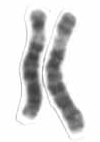Related Research Articles

The spindle checkpoint, also known as the metaphase-to-anaphase transition, the spindle assembly checkpoint (SAC), the metaphase checkpoint, or the mitotic checkpoint, is a cell cycle checkpoint during metaphase of mitosis or meiosis that prevents the separation of the duplicated chromosomes (anaphase) until each chromosome is properly attached to the spindle. To achieve proper segregation, the two kinetochores on the sister chromatids must be attached to opposite spindle poles. Only this pattern of attachment will ensure that each daughter cell receives one copy of the chromosome. The defining biochemical feature of this checkpoint is the stimulation of the anaphase-promoting complex by M-phase cyclin-CDK complexes, which in turn causes the proteolytic destruction of cyclins and proteins that hold the sister chromatids together.

A kinetochore is a disc-shaped protein structure associated with duplicated chromatids in eukaryotic cells where the spindle fibers attach during cell division to pull sister chromatids apart. The kinetochore assembles on the centromere and links the chromosome to microtubule polymers from the mitotic spindle during mitosis and meiosis. The term kinetochore was first used in a footnote in a 1934 Cytology book by Lester W. Sharp and commonly accepted in 1936. Sharp's footnote reads: "The convenient term kinetochore has been suggested to the author by J. A. Moore", likely referring to John Alexander Moore who had joined Columbia University as a freshman in 1932.
Monopolin is a protein complex that in budding yeast is composed of the four proteins CSM1, HRR25, LRS4, and MAM1. Monopolin is required for the segregation of homologous centromeres to opposite poles of a dividing cell during anaphase I of meiosis. This occurs by bridging DSN1 kinetochore proteins to sister kinetochores within the centromere to physically fuse them and allow for the microtubules to pull each homolog toward opposite mitotic spindles.

Chromosome 6 is one of the 23 pairs of chromosomes in humans. People normally have two copies of this chromosome. Chromosome 6 spans more than 172 million base pairs and represents between 5.5 and 6% of the total DNA in cells. It contains the major histocompatibility complex, which contains over 100 genes related to the immune response, and plays a vital role in organ transplantation.

Chromosome 17 is one of the 23 pairs of chromosomes in humans. People normally have two copies of this chromosome. Chromosome 17 spans more than 84 million base pairs and represents between 2.5 and 3% of the total DNA in cells.

Cell division cycle protein 27 homolog is a protein that in humans is encoded by the CDC27 gene.

Kinetochore protein NDC80 homolog is a protein that in humans is encoded by the NDC80 gene.

Cell division cycle protein 16 homolog is a protein that in humans is encoded by the CDC16 gene.

Mitotic checkpoint protein BUB3 is a protein that in humans is encoded by the BUB3 gene.

Centromere protein C 1 is a protein that in humans is encoded by the CENPC1 gene.

Kinetochore protein Nuf2 is a protein that in humans is encoded by the NUF2 gene.

Centromere/kinetochore protein zw10 homolog is a protein that in humans is encoded by the ZW10 gene. This gene encodes a protein that is one of many involved in mechanisms to ensure proper chromosome segregation during cell division. The encoded protein binds to centromeres during the prophase, metaphase, and early anaphase cell division stages and to kinetochore microtubules during metaphase.

Centromere protein H is a protein that in humans is encoded by the CENPH gene. It is involved in the assembly of kinetochore proteins, mitotic progression and chromosome segregation.
KNL1 is a protein that is encoded by the KNL1 gene in humans.

Kinetochore-associated protein NSL1 homolog is a protein that in humans is encoded by the NSL1 gene.

Protein MIS12 homolog is a protein that in humans is encoded by the MIS12 gene.

Kinetochore protein Spc24 is a protein that in humans is encoded by the SPC24 gene.

DSN1, MIND kinetochore complex component, homolog , also known as DSN1 or MIS13, is a protein which in humans encoded by the DSN1 gene.
Carpediemonas is genus of Metamonada, and belongs to the group Excavata. This organism is a unicellular flagellated eukaryote that was first discovered in substrate samples from the Great Barrier Reef. Carpediemonas can be found in anaerobic intertidal sediment, where it feeds on bacteria. A feature of this species is the presence of a feeding groove, a characteristic of the excavates. Like most other metamonads, Carpediemonas does not rely on an aerobic mitochondrion to produce energy. Instead, it contains hydrogenosomes that are used to produce ATP. This organism has two flagella: a posterior one used for feeding on the substrate, and an anterior one that moves in a slower sweeping motion. Carpediemonas is assigned to the fornicates, where similar Carpediemonas-like organisms are used in researching the evolution within excavates. Although Carpediemonas is a member of the metamonads, it is unusual in the sense that it is free-living and has three basal bodies.

Andrea Musacchio is an Italian structural biologist. He is Max Planck director at the Institute of Molecular Physiology in Dortmund. He is also Honorary Professor at the Center for Medical Biotechnology at the University of Duisburg-Essen. He was named European Molecular Biology Organization member in 2009.